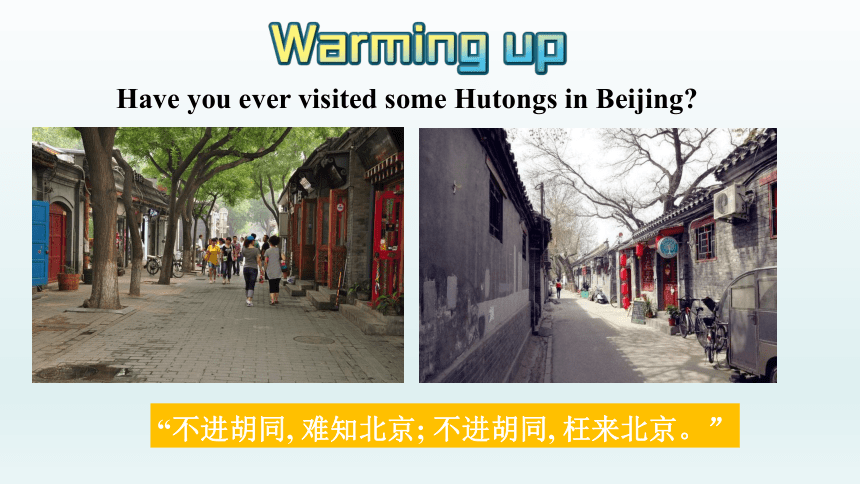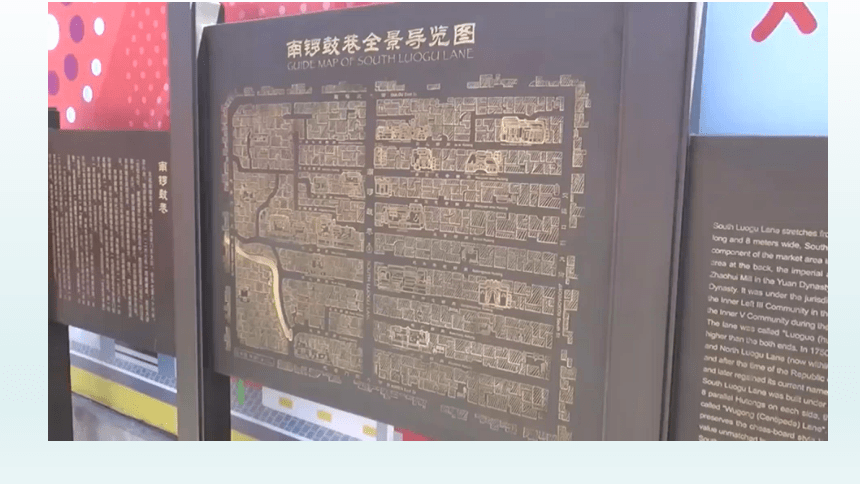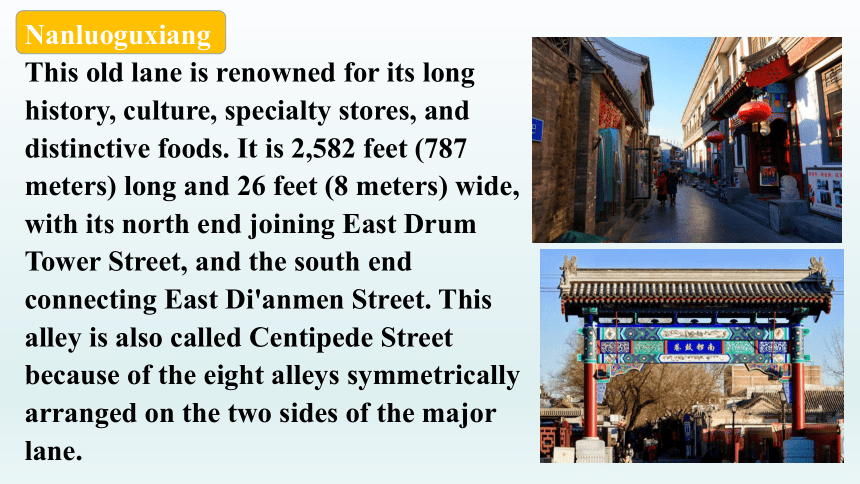北师大版(2019)选择性必修第四册 Unit10 Connections Reading Club1 课件(共18张PPT)
文档属性
| 名称 | 北师大版(2019)选择性必修第四册 Unit10 Connections Reading Club1 课件(共18张PPT) |  | |
| 格式 | pptx | ||
| 文件大小 | 133.8MB | ||
| 资源类型 | 教案 | ||
| 版本资源 | 北师大版(2019) | ||
| 科目 | 英语 | ||
| 更新时间 | 2023-03-17 20:45:49 | ||
图片预览







文档简介
(共19张PPT)
Unit 10
Unit 10
Connections
Hutong
To read and talk about hutongs
To read for understanding and critical thinking
To summarise information
Have you ever visited some Hutongs in Beijing
“不进胡同, 难知北京; 不进胡同, 枉来北京。”
Nanluoguxiang
This old lane is renowned for its long history, culture, specialty stores, and distinctive foods. It is 2,582 feet (787 meters) long and 26 feet (8 meters) wide, with its north end joining East Drum Tower Street, and the south end connecting East Di'anmen Street. This alley is also called Centipede Street because of the eight alleys symmetrically arranged on the two sides of the major lane.
Dongjiaominxiang
Together with Xijiaomin Lane, they are called the longest hutong in Beijing, with a length of 9,843 feet (3 kilometers). Stretching from East Tiananmen Square Road to Chongwenmen Inner Street, Dongjiaomin Lane used to be the location of many foreign embassies. There are also sites of old churches, banks, official mansions and clubs. Buildings there form the only European style block in Beijing, which contains the early 20th-century features.
Sanmiao Street
It is the oldest one dated from the Liao Dynasty.
Qianshi Hutong
It was the location of money market (Qianshi) in the Qing Dynasty. Known as the narrowest one in Beijing, its narrowest point is about 1.3 feet (0.4 meters) wide.
1. What is a hutong
Hutongs refer to alleys that connect the rectangular courtyards of traditional Chinese houses, and nowadays it is also used to describe the courtyards themselves and communities that live there, which offer a rare view into China’s past.
How are hutongs arranged
The homes of the nobles and wealthy citizens were in the hutongs closest to the royal palace. Ordinary citizens lived in the hutongs further away from the palace.
2. When and why were hutongs built
Most of Beijing’s hutongs were built during the Yuan, Ming and Qing Dynasties (between the 13th and 19th centuries) to help the Emperors keep control over the city by placing guards at the entrances of the various hutongs.
3. What features of hutong living can you find in the text
the houses were built facing each other around countryards, …
the families supported each other when help was needed and shared the joy and sorrow of everyday life…
working, playing and living together
4. Development of Beijing’s hutongs:
During the Yuan, Ming and Qing Dynasties: The majority were built.
Towards the end of the Qing Dynasty: The conditions ___________.
When the People’s Republic of China was set up: The government took measures to protect many of the ________ hutongs.
Now: They are still an important part of Beijing life. They link Beijing’s _________________ as well as its streets and communities.
past and present
went down
oldest
Why does the writer say hutongs link the past and present
Hutongs are a feature of ancient Chinese architecture. They are still busy part of Beijing as it used to be when they were first built.
Discuss the reasons that support the writer’s idea.
Write a short passage on whether you agree or disagree the idea above.
Unit 10
Unit 10
Connections
Hutong
To read and talk about hutongs
To read for understanding and critical thinking
To summarise information
Have you ever visited some Hutongs in Beijing
“不进胡同, 难知北京; 不进胡同, 枉来北京。”
Nanluoguxiang
This old lane is renowned for its long history, culture, specialty stores, and distinctive foods. It is 2,582 feet (787 meters) long and 26 feet (8 meters) wide, with its north end joining East Drum Tower Street, and the south end connecting East Di'anmen Street. This alley is also called Centipede Street because of the eight alleys symmetrically arranged on the two sides of the major lane.
Dongjiaominxiang
Together with Xijiaomin Lane, they are called the longest hutong in Beijing, with a length of 9,843 feet (3 kilometers). Stretching from East Tiananmen Square Road to Chongwenmen Inner Street, Dongjiaomin Lane used to be the location of many foreign embassies. There are also sites of old churches, banks, official mansions and clubs. Buildings there form the only European style block in Beijing, which contains the early 20th-century features.
Sanmiao Street
It is the oldest one dated from the Liao Dynasty.
Qianshi Hutong
It was the location of money market (Qianshi) in the Qing Dynasty. Known as the narrowest one in Beijing, its narrowest point is about 1.3 feet (0.4 meters) wide.
1. What is a hutong
Hutongs refer to alleys that connect the rectangular courtyards of traditional Chinese houses, and nowadays it is also used to describe the courtyards themselves and communities that live there, which offer a rare view into China’s past.
How are hutongs arranged
The homes of the nobles and wealthy citizens were in the hutongs closest to the royal palace. Ordinary citizens lived in the hutongs further away from the palace.
2. When and why were hutongs built
Most of Beijing’s hutongs were built during the Yuan, Ming and Qing Dynasties (between the 13th and 19th centuries) to help the Emperors keep control over the city by placing guards at the entrances of the various hutongs.
3. What features of hutong living can you find in the text
the houses were built facing each other around countryards, …
the families supported each other when help was needed and shared the joy and sorrow of everyday life…
working, playing and living together
4. Development of Beijing’s hutongs:
During the Yuan, Ming and Qing Dynasties: The majority were built.
Towards the end of the Qing Dynasty: The conditions ___________.
When the People’s Republic of China was set up: The government took measures to protect many of the ________ hutongs.
Now: They are still an important part of Beijing life. They link Beijing’s _________________ as well as its streets and communities.
past and present
went down
oldest
Why does the writer say hutongs link the past and present
Hutongs are a feature of ancient Chinese architecture. They are still busy part of Beijing as it used to be when they were first built.
Discuss the reasons that support the writer’s idea.
Write a short passage on whether you agree or disagree the idea above.
同课章节目录
- Unit 10 Connections
- Lesson 1 How Closely Connected Are We?
- Lesson 2 Community Spirit
- Lesson 3 Anne of Green Gables
- Unit 11 Conflict And Compromise
- Lesson 1 Living In a Community
- Lesson 2 Dealing with Conflict
- Lesson 3 War Memories
- Unit 12 Innovation
- Lesson 1 Scientific Breakthroughs
- Lesson 2 Aha Moment
- Lesson 3 Stephen Hawking
